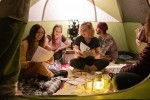A rustling sound outside a tent can’t mean anything good in a horror movie, but this takes a twist in “Camp Willowcreek.”
Two girls encounter this situation in third-year film and television student Nora McCoy’s short film, which follows their discovery of a strange forest creature while camping. But the potential threat evolves into a gentle, friendly monster to show that looks can be deceiving, McCoy said. Despite their fears, the creature simply wants to socialize and play cards with the campers, showing they had no reason to be scared. Filmed in May, the horror film is meant to be funny while maintaining the poignant message that not everything is as it seems, McCoy said.
“Being scared in a tent in the dark is a universal thing we’ve all seen in horror movies,” McCoy said. “With comedy, I wanted to show that most of it happens in your head.”
[RELATED: Upcoming student film tells a ghost story centered on childlike innocence]
The horror genre relies on the fear of others, but McCoy said it has a high potential to be cheesy because it’s easy for the audience to see what filmmakers are attempting. If their attempt fails in a given scene, the moment is ruined and rendered humorous. McCoy said the horror genre can be tricky to execute well because it’s so subjective, so she decided to mix comedy into her film through the forest monster’s friendly attitude.
But blending two moods is not as simple as it sounds, McCoy said, especially considering the filming method used. The entire movie was filmed in a six-person tent often occupied by seven people, and cameras and lighting equipment made it difficult to film from multiple angles, McCoy said.
To help her with the cinematographic elements that created a sense of horror, McCoy enlisted help from third-year film and television student Katie Speare, who was the director of photography for the project. Speare used photographic tools such as vintage lighting to capture the combination of genres. The rustic light gave the film a near-sepia tone, giving the tent an eerie ambiance, Speare said. To achieve a classic horror vibe, there was an antique-looking lantern hanging from the top of the tent, Speare said. There were also lights shining from under the actors’ faces, recalling the classic image of people telling scary stories by a campfire.
The lighting in particular contributed to the horror aesthetic, McCoy said. But the responsibility of encapsulating the scary mood also fell on the actors, especially actors who have to act inhuman, McCoy said. Actor Jesse Contente, who played the forest monster named Steve, said the film used close-up shots in which he’d flash his gross, stained teeth, and one of the girls would scream, further contributing to the classic horror vibe.
“I basically had to forget everything I knew about human interactions to play Steve,” Contente said.
These close-up shots were supposed to be over-the-top, including dramatic sound effects like the screeching violin, Speare said. Despite the fictitious nature of the monster, the character was grounded in reality, Contente said; he was depicted as a man who had been in the forest for so long that he forgot how to be a person. The supernatural element of a forest monster was absent in Contente’s character – he just looked like a dirty, roughed-up human covered in leaves, McCoy said.
“The friendly forest monster was where the comedy met the horror,” McCoy said. “The fact that he was nice and wanted to sit down and play games in the tent transformed the elements of horror into something funny.”
[RELATED: Student-made film shines a light on escapism and its consequences]
This is where the film’s central theme manifested itself, Speare said, because things can look scary but looks can be deceiving. By balancing comedy and horror, “Camp Willowcreek” not only pokes fun at the horror genre, but also at irrational human fears – because the monster under your bed might just want to be your friend.
“We wanted to show through comedy and horror that our fear of the unknown is sometimes ridiculous,” McCoy said. “In fact, it usually is.”
